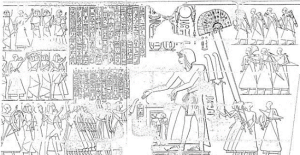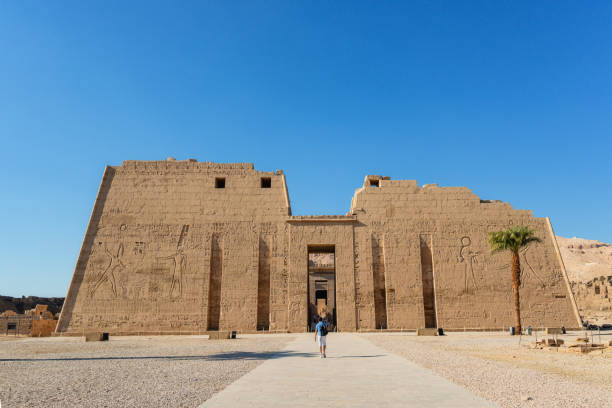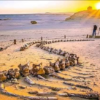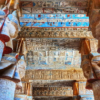The Region of Habu
A sacred region for the ancient Egyptians, as they believed it was the place where Amun-Ra appeared. Therefore, every year a festival called the “Valley Festival” was held, in which the god Amun visited his ancestors (in the second month of summer). Thus, the temple was called “The United with Eternity”. Construction in this area began in the era of the 18th dynasty, with kings Amenhotep I, Thutmose I, Hatshepsut, and Thutmose III. There is also a chapel from the Middle Kingdom in front of the temple, and chapels for princesses from the 25th dynasty. The current temple was built by King Ramses III of the 20th dynasty and is the largest funerary temple for the kings of the New Kingdom
King Ramses III, the last of the great kings of Egypt in the 20th dynasty
married many queens, the most important of whom was Queen Titi, who bore him two sons: Khaemwaset and Amonherkhepeshef, who both died in their father’s lifetime. At the end of his reign, we learned from the Harris Papyrus that a conspiracy called the “wives’ Conspiracy” was plotted against him. One of his wives wanted to conspire against him so that her son could assume the throne, but he discovered the plot and executed the mother and son. It is believed that the mummy of a hanged young man found is for the son of Ramses III. This great king, 1193 BC, fought the peoples of the Mediterranean (ancestors of the Libyans and inhabitants of the Mediterranean islands such as Sardinia and Malta) who tried to conquer Egypt. His reign was a period of stability and he succeeded in all his wars, especially against the peoples of the Mediterranean and the Syrians. The wars with Syrians lasted for long times AS they fortified themselves in fortresses called Majdal. Hence the idea of building his temple like the Syrian fortresses and castles, as a result of their being in fortified castles. He carried out many constructions, such as his funerary temple here in the west bank, his magnificent tomb in the Valley of the Kings, and the tombs of his wife and children in the Valley of the Queens. He also built a small temple in the first courtyard in Karnak.
The Temple of Habu
It measures 200 meters wide by 320 meters long. It is the only one that is fortified, meaning it has an inner and outer wall. There was also a palace for King Ramses III around the temple, from which he could overlook the temple during his visits. They also built a sacred pool representing the primordial waters, Nun. King Ramses III built this temple in the style of the Syrian fortresses known as “Majdal”. It consists of two towers with balconies, with a gate between them that serves as the entrance.
An aerial view of the Temple of Habu.
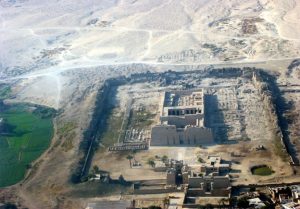
A view of the facade of the Temple of Habu.
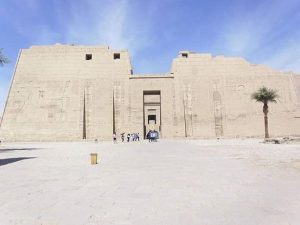
The Temple Gateway (Pylon)
The pylon in any temple is a massive structure. It is built in the form of two fortresses, each representing the eastern and western mountains of Egypt, with the entrance to the temple between them. The purpose of the pylon was to protect the temple and instill awe in the visitors of the temple. Therefore, it is always decorated with scenes of the king smiting his enemies.
The most important parts of the pylon are
• The Flagstaffs: In each pylon, there are a number of openings, between two or four, for the installation of wooden flagstaffs. The flags were in four colors: white, green, red, and blue. • The Egyptian Cornice: In the middle of the pylon, we always find a cornice connecting the two mountains, with a winged sun disk on it. • The idea originated from the Egyptian palm branches, which was used as a roof in huts, and thus became a traditional decoration in stone architecture.
The method of building the pylon
The first course is laid and the surface is carved from the stones. Then, ascending ramps are built and the stones are dragged on sledges pulled by oxen. After the first course is completed, the ramps are raised higher until the second course is completed, and so on until the construction is finished. Then, when the temple is covered and inscribed, the carving and covering begin from the top down. Therefore, the ramps are removed from the top down.
Description of the Temple
Description of the Pylon (Outer Gate) This gate is like the fortified gates in the Syrian castles (Majdal). It is a gate with two towers, and on each tower is a group of rooms. On its two facades are scenes of Ramses III slaughtering enemies in front of the gods Amun-Ra and Ra Hor Akhty. Also, at the bottom of the tower are two statues of the goddess Sekhmet, the goddess of war. At the top of the tower, we find the famous wives’ room, in which there are scenes of the king playing with his wives, wearing light clothes. This is a unique scene in the temples.
A view of the facade of the Temple of Habu, we find two statues of the goddess Sekhmet and above them the upper rooms that the king used with his wives.
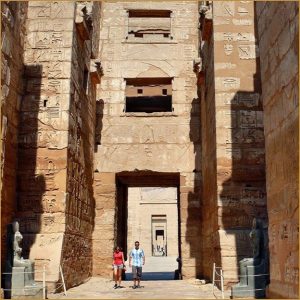
The goddess Sekhmet.
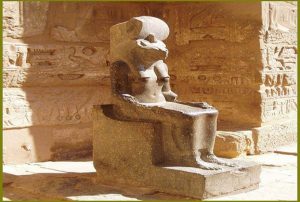
The gate of the temple.
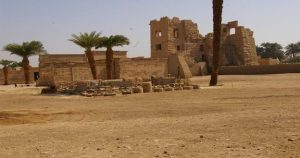
An inscription showing the king inside his war chariot.

Scenes of the temple facade.
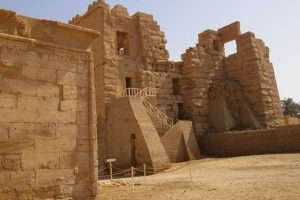
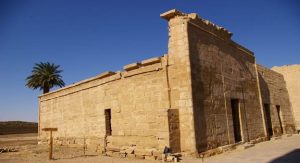

After that, we find the chapels of the princesses of the 25th dynasty, the most important of which is the chapel of Princess Amon-Radis, daughter of the Nubian King Kashta. There are also scenes in these chapels depict the princesses with different gods. We also find the remains of a temple from the 18th dynasty.
A view of the open courtyard, the chapels of the princesses of the 25th dynasty, and the remains of the 18th dynasty.
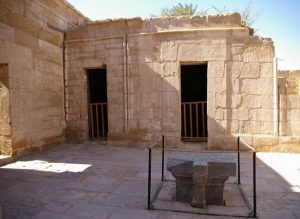
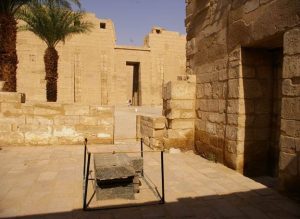
Inscriptions on the temple facade.

Scenes of the temple gate.

The Inner Gate
We find on it the usual warlike scenes of King Ramses III killing enemies in front of Amun-Ra and Ra Hor Akhty. A beautiful scene on the right tower shows the king kneeling among the leaves of the sacred tree in front of the god Amun and Thoth, the god of wisdom, inscribing the king’s name on it. This signifies the length of the king’s reign and his long rule.
The Open Courtyard in the Temple of Habu
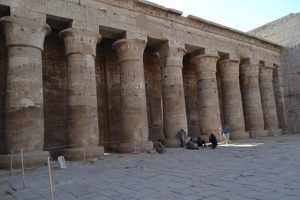
The Open Courtyard in the Temple of Habu The king, after his victory, ties the enemies with a rope and presents them to the god Amun, who gives him the sword of victory.
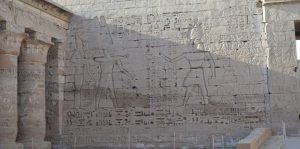
The First Courtyard
The northern side of it has 7 Osirian columns, while the southern side has 8 round columns.
The most important scenes:
The king pursuing and fighting the Sea Peoples in the eighth year of his reign. A scene of the king hunting wild Bulls
The window from which the king looked out to watch the celebrations.
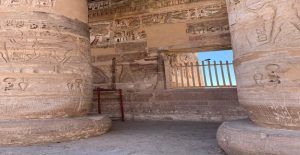
An image of the king on one of the columns worshipping the goddess Sekhmet, the goddess of war, and above her an image of the king kneeling before Ptah.
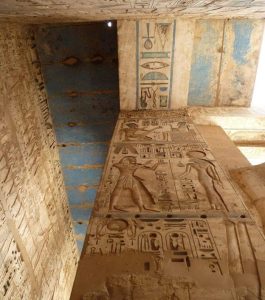
The king offers offerings to the god Amun-Ra, and also a scene of the god Ra-Horakhty giving the king the key of life.

A scene of the king kneeling before the goddess Sekhmet, and below her the king before Anubis.

The king holds the heads of his enemies in his hand and strikes his enemies, causing fear among them.
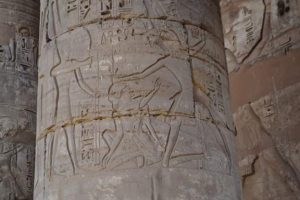
The king, with the blue crown, behind him the god Thoth writes the king’s name as an honor for him
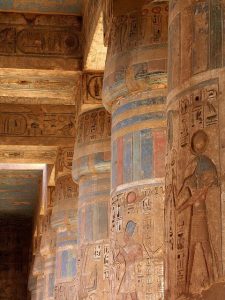
The king holds the head of one of the enemies in his hand and strikes him with his mace.

The king offers lotus flowers to the god Amun-Ra, and behind him stands his wife Mut.
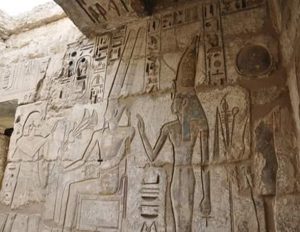
The god Amun-Ra gives the sword of victory to the king to help him in the war, and the goddess Mut stands behind her husband.
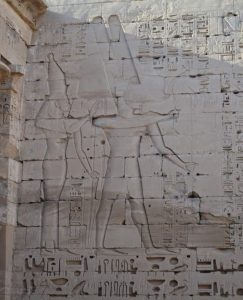
It has been mentioned that when the peoples of the Mediterranean (the Libyans and the inhabitants of the Mediterranean islands) began to threaten Egypt, King Ramses III uttered his famous saying: “May the hand of anyone who harms Egypt be cut off.” Therefore, during the war, the king would give a reward to anyone who killed the enemies and cut off their hands. There is a magnificent scene in this temple called “The Scene of Cutting Off Hands,” in which the king is seated on his throne and in front of him are the hands of the enemies cut off, presented to him by one of his commanders. There is a scribe recording the number of hands cut off.
The scene of cutting off the hands of the enemies. We find the king sitting on the throne, with the hands of the enemies presented to him by one of his pimps
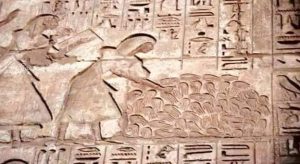
A scene of cutting off the hands of enemies in front of the king

The Second Courtyard (Osirian)
The northern and southern sides, each consists of 5 round columns in the shape of papyrus buds. While the eastern and western sides are in the form of 8 Osirian columns, hence the name “Osirian courtyard.” Behind the western row is another row of round columns in the shape of buds. The most important scenes in this courtyard on the walls are : the celebration of the god Ptah and the god Min (god of fertility). There are also scenes of the king offering various offerings to the gods. Below them are scenes of the king’s wars.
Hall of Osirian Columns
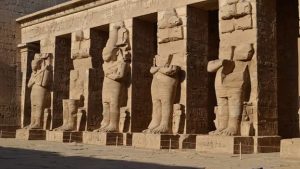
Hall of Osirian Columns
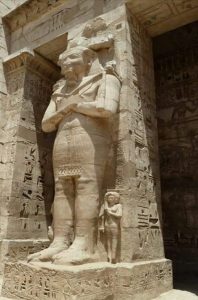
The First Hypostyle Hall
Composed of 24 columns arranged in 4 rows in the shape of papyrus plants. All the scenes of the king with the various gods surround the hall. There are important chambers surrounding the hall, the most important of which are: • Number 1: On the right of the entrance for King Ramses III. • Number 2: For the god Ptah. • Number 5: For sacrifices. • Number 7: For the boat of Amun. Then, on the left, the most important are: • Number 14: The chamber of the boat of the god Amun. • Number 15: The god Montu, the god of war.
Ramses III burns incense before Ptah.
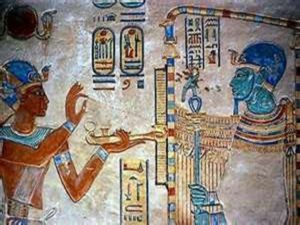
The king holds an image of himself as a young man while he builds the temple and presents it to Amun-Ra.
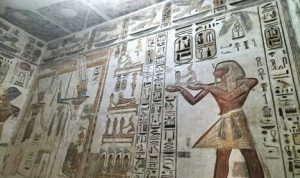
Isis presents the four bulls to Amun-Ra in celebration of the king’s victories.
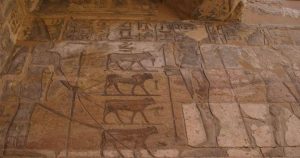
Ramses III burns incense before Amun Ra.

The Second and Third Hypostyle Halls and the Holy of Holies
Each hall has 8 columns inscribed with scenes of the king with the gods. At the end of the third hall, we find the Holy of Holies, which contains the Theban triad: Amun in the middle, Mut on the right, and Khonsu on the left.
The third hypostyle hall.
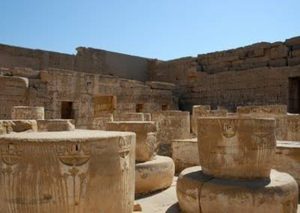
Ramses III celebrates his victory over the Libyans.
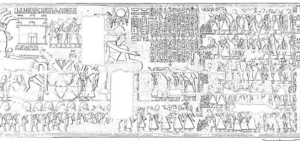
Ramses III celebrates his victory over the Libyans while counting his Libyan prisoners.
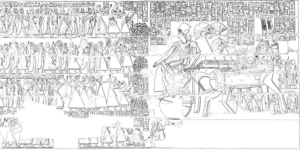
Ramses III celebrates his victory over the Libyans.
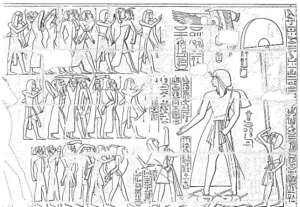
Ramses III displays the Libyan prisoners and spoils.
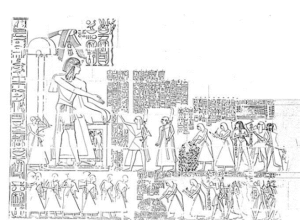
Ramses III celebrates his victory over the Sea Peoples.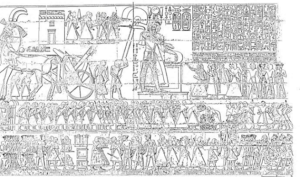
Ramses III celebrates his victory over the Syrians.